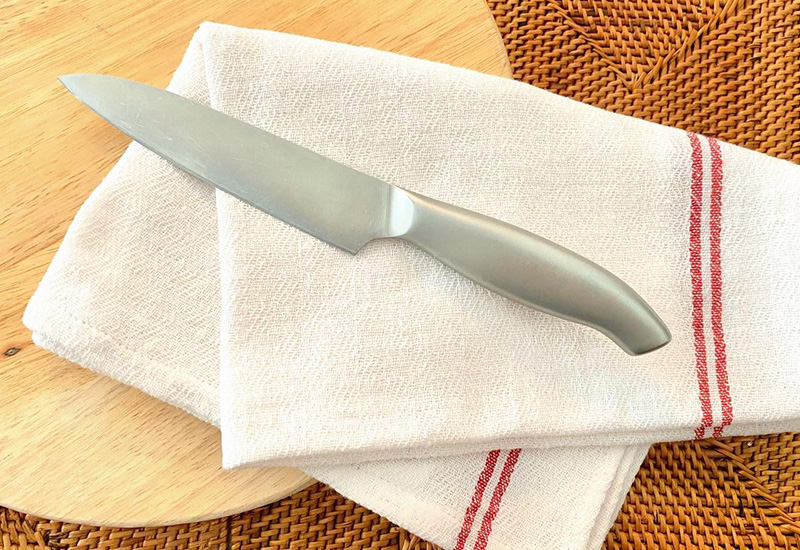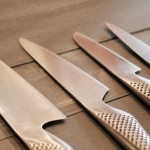Japanese Knives Sharpening Guide Part 2

In this Part 2 guide, we’ll continue discussing how to properly sharpen your Japanese knives to maintain its cutting performance and ensure that the knives last many years. In our Part 1 guide, we discussed the first 5 steps to prepare your knife for sharpening, so if you haven’t read that, please check it out before continuing on to step 5 below.
Sharpen the right side of the blade
As mentioned in step 5, you’ll need to find the correct bevel sharpening angle before beginning sharpening. Once you’ve found the correct angle, push the cutting edge of your knife into the stone using two or three fingers of your left hand. Next, push the knife forward and back along the entire length of the stone while maintaining the same angle. As you push the knife forward, apply slight pressure with your left hand, and release the pressure as you pull back. The most important thing to keep in mind while you sharpen the knife is to maintain the same angle at all times. For beginners, it’s recommended to check the knife after every few strokes to see your progress and make adjustments. As you continue to sharpen the water on the whetstone will turn murky and black. This darkened and muddy water actually helps to sharpen the blade smoothly, so don’t change the water. If the whetstone becomes dry, you can add water to it.
Sharpen the left side of the blade
After you’ve sharpened the right side, flip the knife over so that the cutting edge is facing away from you and repeat the same sharpening process. The position of your right hand will be slightly different when sharpening the left side of the knife, as your index finger should be placed on the face of the knife with your thumb on the spine. For the area of the knife closest to the handle, it helps to rotate the knife perpendicular to the stone so that the handle is not in the way. Burr that is created from sharpening the right side of the blade will be removed when sharpening the left side. If the knife’s bevel is non-symmetrical, you may need to adjust and find the correct bevel sharpening angle again.
Remove burrs, and testing sharpness
Burrs that are created during the sharpening process can be removed by very lightly sliding the edge of the knife across the whetstone. Another option to remove the burrs is to gather a stack of newspapers and gently slide the knife back and forth, sliding the knife’s edge across a cork, or cutting through a roll of newspapers until the blade is smooth. Removing burrs is necessary to ensure the blade has a clean edge, which improves its performance as you cook. Once the burrs are removed, you can test the sharpness of your knife by slicing a piece of paper.
Repeat process with higher grit whetstone (if necessary)
If necessary, you can use a higher grit whetstone to polish the blade. This will give your knife a better shine and help remove any remaining burrs.
Wash/dry knife and whetstone.
Your newly sharpened blades should be hand washed and dried. Whetstones should be rinsed off, wiped dry, and stored somewhere away from sunlight.
If you’ve followed our 10 steps, then you are now finished and have successfully sharpened your Japanese knife! Some points to keep in mind as you sharpen your knife is that every time it’s sharpened, steel is removed. As a beginner, you might be removing more steel than necessary, however as you get more experienced in knife sharpening, you’ll be able to adjust and sharpen the blade just enough so that you achieve a sharp edge while removing the least amount of steel. While sharpening a knife may seem like a daunting task, it’s an incredibly useful skill! Now that we’ve learned the basic steps required to sharpen double-beveled Japanese knives, it’s time to move on to single-bevel knives. Single bevel knives require a different technique to sharpen due to the more complicated bevel shape. Additionally, different types of Japanese knives require different sharpening techniques. If you’re not comfortable sharpening your own knives, there are knife sharpening services available and many manufacturers also offer sharpening services.

